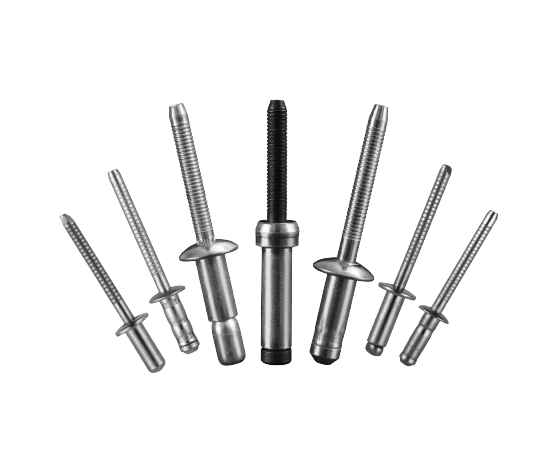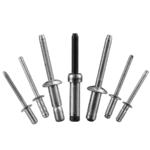Table of Contents

Rivet is one of the very widely used fasteners. So do you know how do rivets work?This guide will give you detailed information about how rivets work and how they connect.
Table of Contents
What Are Rivets?
Rivets are a very common fastener for thin plate connections. You can find rivets anywhere, whether it’s in cars, airplanes, bridges, furniture, appliances or industrial equipment.

So how is a rivet constructed? The basic construction of a rivet consists of three parts: 1. rivet head 2. rivet stem 3. rivet tail.
- Head: fixed to the surface of the material, used to provide clamping force. Common types include round head, large brim, countersunk head, etc.
- Shank: The long column part of the rivet, which undergoes plastic deformation during installation.
- Tail: The material that deforms after stretching or compression and clamps the joint together with the head.
How do Rivets Work? - Core Elements
Why do rivets form a tight connection? Then you need to have a clear perception of how rivets work. Here are the key factors that influence “how do rivets work”.
1. Plastic Deformation
Plastic deformation of the rivet tail is the key to the connection:
- Deformation to absorb external forces: the tail deforms to absorb the applied tensile force or pressure.
- Material fixation: the diameter of the deformed tail is larger than the hole diameter, preventing the rivet from coming out.
2. Clamping Force

What is the clamping force of a rivet? It is when the head and tail of the rivet together exert a clamping force on the material. Its function is mainly to prevent the material from slipping or loosening and to maintain the stability of the connection.
Of course, you can avoid material damage by spreading the stress through head design (e.g., large flange head blind rivets).
3.Material Compatibility
The properties of the rivet and the connecting material need to be matched:
- Ensure that the strength of the rivet is sufficient to support the connection requirements.
- Prevent failure due to galvanic corrosion.
How do Rivets Work?
So do you know how to install rivets?How do rivets work?Rivets are installed to achieve a stable mechanical connection through the following steps.
1. Pre-drill Holes and Insert Rivets
Drilling or Punching:
- Drill holes in the material to be joined to match the rivet diameter (usually 0.1-0.2mm larger than the rivet diameter).

Insert the rivet:
- Insert the rivet into the hole in the material with the head against the surface of the material.
2. Riveting tool action
The use of a rivet gun to apply tension or pressure to the stem or mandrel of a rivet. The rivet gun causes the end of the rivet to deform plastically, creating a strong “locking” structure.
3. Material Clamping
The rivet gun causes the tail of the rivet to deform so that the tail and head work together to securely attach the rivet to the material being joined.
- The head provides the clamping force on the outside and the deformed tail locks the material on the inside.
- The materials are tightly clamped to each other to form a strong connection.

Contact Our Engineers Today
We provide you with high quality rivets, including customized services.
How Different Types of Rivets Work?
Although rivets work on roughly the same principle, there are some differences in how different types of rivets work.
Solid Rivets
Principle of operation:
- Use hammering, hydraulic or pneumatic equipment to deform the end of the rivet to form a lock.
- Commonly used in bridges, airplanes, and high-strength steel structures.
Deformation characteristics:
- Plastic deformation of the entire rivet stem.
Blind Rivets
Principle of operation:
- The tool applies tensile force to pull the mandrel upward, the shell tail deforms to clamp the material, and the mandrel breaks to complete the installation. Suitable for one-sided operation, commonly used for thin steel plates, tubes or closed structures.
Deformation Features:
- Deformation of shell tail, broken mandrel provides additional locking force.
Structural Rivets
Principle of operation:
- Based on a blind rivet, a mechanical lock is formed between the mandrel and the shell, providing increased strength and vibration resistance.
- Commonly used in high vibration, high dynamic load environments (e.g. aerospace, railroad vehicles).

Deformation characteristics:
- Mandrel locking for enhanced resistance to loosening.
Principle of operation:
- When the tool applies pressure, the tail of the rivet splits into multiple directions, creating a large deformation.
- Suitable for soft materials or thin plates to prevent material damage.

Deformation characteristics:
- Tail splits outward to increase clamping area.
Aside from understanding how do rivets work, you also need to use the pros and cons of using rivets.
Advantages of Using Rivets
- Reliable mechanical connection: rivets form a fixing by plastic deformation, providing high tensile and shear strength, suitable for scenarios subjected to static or dynamic loads.
- No Thermal Effects: Riveting is a cold working process and does not have the thermal effects on material properties that welding does.
- Suitable for one-sided operation: the use of blind rivets can be accomplished in areas where the back side is inaccessible, such as closed structures, tubes or frames.
- Easy to operate: riveting equipment is simple and easy to operate, suitable for assembly line assembly and field construction.
- Applicable to a variety of materials: rivets are suitable for metal (such as steel, stainless steel, aluminum) as well as non-metallic materials (such as plastics, composite materials), stable connection performance.
- Lightweight design: lightweight materials such as aluminum rivets can be used in applications that require weight reduction.
- No need for special environment: riveting does not require a dry, wind-free operating environment like welding, and can be installed in wet or harsh conditions.
- Low cost and high efficiency riveting process is simple and fast, especially suitable for high-volume production, reducing production and assembly costs.

Disadvantages of Using Rivets
- Limited strength: riveted joints are usually less strong than welded or bolted joints.
- Unsuitable for thick materials: rivets are limited in length, making it difficult to join thicker materials or multiple layers of materials.
- Holes weaken the material: riveting requires drilling holes in the material, which may weaken the overall strength of the material, especially in thin plates or stress critical areas.
- The operation process is not reversible: it is difficult to recover the rivet once it has been deformed.
Applications of Rivets
| Industry | Examples of Applications |
| Construction Work | Steel framing, bridge connections, guardrail installation. |
| Vehicle | Aircraft fuselage riveting, automobile compartment connection, ship steel plate splicing. |
| Industrial equipment | Machinery housings, pipe supports, equipment frames. |
| Consumer goods manufacturing | Steel furniture, metal appliance housings, decorative riveting (e.g. garment fasteners). |
Custom High Quality Rivets for You
This guide helps you understand “how do rivets work”, do you need to buy rivets for your business? If you do, please contact the blind rivet manufacturer – Rivmate.



